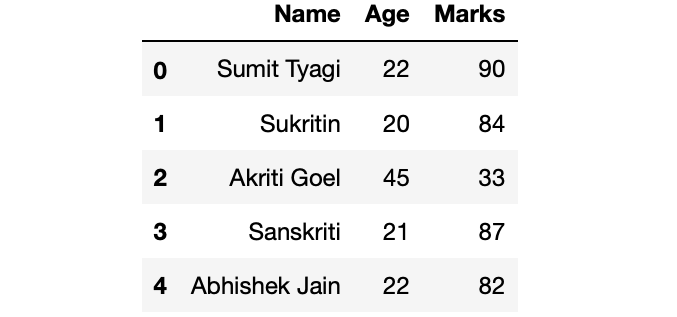在 Pandas 中突出显示每列中的最小值
在本文中,我们将讨论如何突出显示 Pandas Dataframe 中的最小值。所以,让我们首先制作一个数据框:
Python3
# Import Required Libraries
import pandas as pd
import numpy as np
# Create a dictionary for the dataframe
dict = {
'Name': ['Sumit Tyagi', 'Sukritin',
'Akriti Goel', 'Sanskriti',
'Abhishek Jain'],
'Age': [22, 20, 45, 21, 22],
'Marks': [90, 84, 33, 87, 82]
}
# Converting Dictionary to
# Pandas Dataframe
df = pd.DataFrame(dict)
# Print Dataframe
print(df)Python3
# Highlighting the minimum values of last 2 columns
df.style.highlight_min(color = 'lightgreen',
axis = 0)Python3
# Defining custom function
# which returns the list for
# df.style.apply() method
def highlight_min(s):
is_min = s == s.min()
return ['color: green' if cell else ''
for cell in is_min]
df.style.apply(highlight_min)Python3
# Defining custom function
# which returns the list for
# df.style.apply() method
def highlight_min(s):
is_min = s == s.min()
return ['background: lightgreen' if cell else ''
for cell in is_min]
df.style.apply(highlight_min)Python3
# Defining custom function
# which returns the list for
# df.style.apply() method
def highlight_min(s):
if s.dtype == np.object:
is_min = [False for _ in range(s.shape[0])]
else:
is_min = s == s.min()
return ['background: lightgreen' if cell else ''
for cell in is_min]
df.style.apply(highlight_min)输出:

现在,来到突出显示部分。我们的目标是突出显示每列中具有最小值的单元格。
方法一:使用df.style.highlight_min()方法。
Syntax: DataFrame.style.highlight_min(subset, color, axis)
Parameters:
- subset: Name of the columns of which you want to find the minimum.
- color: Name of the color with which you want to highlight the cell
- axis: {0 or ‘index’, 1 or ‘columns’} based on which axis you want find the minimum.
Returns: Styler object.
示例:突出显示每列中具有最小值的单元格。
Python3
# Highlighting the minimum values of last 2 columns
df.style.highlight_min(color = 'lightgreen',
axis = 0)
输出:

方法二:使用df.style.apply()方法。
Syntax: DataFrame.style.apply(self, func, axis=0, subset=None, **kwargs)
Parameters:
- func: It should take a pandas.Series or pandas.DataFrame based on the axis and should return an object with the same shape.
- axis: {0 or ‘index’, 1 or ‘columns’, None}, default 0. Apply to each column (axis=0 or ‘index’), to each row (axis=1 or ‘columns’), or to the entire Dataframe at once with axis=None.
- subset: Set of columns or rows on which you want to call the func.
- **kwargs: Pass along to func.
Returns: Styler object.
示例 1:突出显示文本而不是单元格。
Python3
# Defining custom function
# which returns the list for
# df.style.apply() method
def highlight_min(s):
is_min = s == s.min()
return ['color: green' if cell else ''
for cell in is_min]
df.style.apply(highlight_min)
输出:

示例 2:突出显示具有最小值的单元格。
Python3
# Defining custom function
# which returns the list for
# df.style.apply() method
def highlight_min(s):
is_min = s == s.min()
return ['background: lightgreen' if cell else ''
for cell in is_min]
df.style.apply(highlight_min)
输出:

示例 3:突出显示具有最小值但不突出显示字符串值的单元格。
Python3
# Defining custom function
# which returns the list for
# df.style.apply() method
def highlight_min(s):
if s.dtype == np.object:
is_min = [False for _ in range(s.shape[0])]
else:
is_min = s == s.min()
return ['background: lightgreen' if cell else ''
for cell in is_min]
df.style.apply(highlight_min)
输出:
